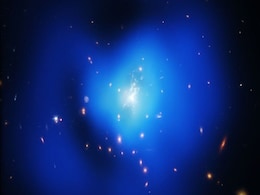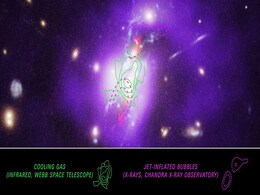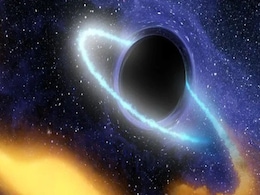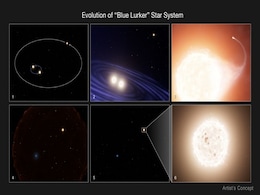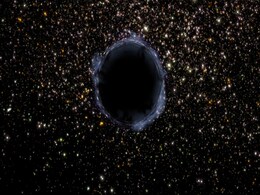Star Cluster
- All
- News
- Videos
-

Hubble Telescope Captures NGC 4536, a Starburst Galaxy with Intense Star Formation
- Wednesday March 26, 2025
- Written by Gadgets 360 Staff
NASA’s Hubble Space Telescope has captured a striking image of NGC 4536, a starburst galaxy 50 million light-years away in the Virgo constellation. The galaxy’s sweeping spiral arms are filled with young blue star clusters and ionized hydrogen gas, indicating rapid star formation. Astronomers believe its bar-like structure channels gas toward t...
-
 www.gadgets360.com
www.gadgets360.com
-

Mysterious Planetary-Mass Objects May Form in Young Star System Clashes
- Wednesday March 12, 2025
- Written by Gadgets 360 Staff
Recent research challenges traditional views on planetary-mass objects, suggesting they may form through violent interactions between young star systems rather than standard planetary or stellar processes. Simulations indicate these clashes create dense gas filaments that evolve into free-floating objects, often in binary pairs. This discovery expl...
-
 www.gadgets360.com
www.gadgets360.com
-

Hubble Captures Stunning Infrared Image of Sh2-284, a Massive Stellar Nursery
- Wednesday March 12, 2025
- Written by Gadgets 360 Staff
Hubble’s latest image of the massive Sh2-284 nebula reveals young stars concealed within thick clouds of gas and dust. Using infrared imaging, astronomers have captured details previously obscured in optical wavelengths. The nebula’s low-metallicity composition provides a glimpse into the conditions of the early universe, shedding light on how ...
-
 www.gadgets360.com
www.gadgets360.com
-

Unexpected Rotational Motion Detected in Ultra-Diffuse Galaxies of Hydra Cluster
- Wednesday March 5, 2025
- Written by Gadgets 360 Staff
Astronomers studying ultra-diffuse galaxies (UDGs) in the Hydra cluster have observed unexpected rotational movement in nearly half of the 30 galaxies examined. Spectroscopic data from the LEWIS programme, using the MUSE instrument on the Very Large Telescope, suggests that gravitational interactions with larger galaxies may influence their formati...
-
 www.gadgets360.com
www.gadgets360.com
-

JWST Identifies Cooling Gas in Phoenix Cluster, Unlocking Star Formation Process
- Thursday February 20, 2025
- Written by Gadgets 360 Staff
The James Webb Space Telescope has detected the missing cooling gas in the Phoenix Cluster, a galaxy cluster located 5.8 billion light-years away. Researchers used the Mid-Infrared Instrument (MIRI) to identify gas at around 540,000 degrees Fahrenheit trapped in cavities within the cluster. This discovery resolves a long-standing mystery of how sta...
-
 www.gadgets360.com
www.gadgets360.com
-

Webb Telescope Unveils Hidden Process Behind Star Formation in Phoenix Cluster
- Friday February 14, 2025
- Written by Gadgets 360 Staff
NASA’s James Webb Space Telescope has uncovered the missing link in star formation within the Phoenix galaxy cluster. By mapping intermediate-temperature gas, researchers identified a crucial phase of cooling that was previously undetected. This discovery explains why the cluster’s supermassive black hole does not fully prevent star formation, ...
-
 www.gadgets360.com
www.gadgets360.com
-

Gravitational Waves Reveal Black Hole Ancestry Through Spin Analysis
- Monday February 3, 2025
- Written by Gadgets 360 Staff
A study published in Physical Review Letters explores how gravitational waves reveal the ancestry of black holes. By examining 69 black hole mergers, researchers found that spin shifts indicate repeated collisions in dense star clusters. This insight supports models suggesting black holes grow through sequential mergers. Observatories like LIGO and...
-
 www.gadgets360.com
www.gadgets360.com
-

Researchers Spot Unusual, Overmassive Globular Clusters in Ultra-Diffuse Galaxy FCC 224
- Friday January 31, 2025
- Written by Gadgets 360 Staff
A new study has uncovered an unexpected globular cluster system in FCC 224, an ultra-diffuse galaxy located in the Fornax cluster. Using data from the Hubble Space Telescope and the Keck Cosmic Web Imager, researchers found that FCC 224 hosts luminous, overmassive globular clusters with unusual properties. The galaxy’s star clusters exhibit narro...
-
 www.gadgets360.com
www.gadgets360.com
-

Invisible Boson Stars Could Hold the Key to Dark Matter's Mysteries
- Tuesday January 28, 2025
- Written by Gadgets 360 Staff
Boson stars, invisible celestial objects theorised to form from axions, are now at the centre of dark matter research. Axions, light and wave-like bosons, may cluster under gravity, forming these mysterious entities. Unlike normal stars, boson stars neither emit light nor interact with regular matter in observable ways. With sizes ranging from smal...
-
 www.gadgets360.com
www.gadgets360.com
-

Webb Telescope Tracks Formation and Expansion of Carbon-Rich Dust Shells in Star System
- Thursday January 16, 2025
- Written by Gadgets 360 Staff
As per the latest report by NASA, the system consists of two stars in an elongated orbit. When these stars come closest, their stellar winds collide, compressing material and forming carbon-rich dust. As reported in an official press release by NASA, Emma Lieb, a doctoral student at the University of Denver and the study's lead author, noted that t...
-
 www.gadgets360.com
www.gadgets360.com
-

NASA’s Hubble Observes Rare Blue Lurker Star with Unusual Evolution in M67 Cluster
- Friday January 17, 2025
- Written by Gadgets 360 Staff
NASA’s Hubble Space Telescope has identified a rare stellar phenomenon called the “blue lurker” in the M67 star cluster. Located 2,800 light-years away, this star is part of a triple-star system and has an unusual evolutionary history. The blue lurker’s accelerated spin, taking just four days, contrasts with the typical rotation of Sun-like...
-
 www.gadgets360.com
www.gadgets360.com
-

Search for Elusive Missing Link Black Holes Continues as Omega Centauri Observation Turns Out to Be a Dud
- Saturday January 4, 2025
- Written by Gadgets 360 Staff
The suspected intermediate-mass black hole in Omega Centauri has been reclassified as a cluster of stellar-mass black holes, according to a recent study. Unusual star movements within the dense cluster were explained using pulsar data, providing new insights into its core dynamics. This discovery reshapes theories about the elusive intermediate-mas...
-
 www.gadgets360.com
www.gadgets360.com
-

New Study Challenges Presence of Intermediate-Mass Black Hole in Omega Centauri
- Friday December 20, 2024
- Written by Gadgets 360 Staff
Research published in Astronomy & Astrophysics revises earlier claims of an intermediate-mass black hole in Omega Centauri. Observed stellar velocities in the dense star cluster are now attributed to stellar-mass black holes. Pulsar data enabled scientists to refine their methods for detecting gravitational fields, offering deeper insights into the...
-
 www.gadgets360.com
www.gadgets360.com
-

James Webb and Chandra Capture Images of Star Clusters in Distant Galaxies
- Thursday December 19, 2024
- Written by Gadgets 360 Staff
NASA’s James Webb Space Telescope and Chandra X-ray Observatory have unveiled stunning new images of two star clusters in the Small Magellanic Cloud. NGC 602, located approximately 200,000 light-years from Earth, showcases active star formation, with dust clouds and ionised gas revealing unique stellar birth conditions. Meanwhile, NGC 2264 featur...
-
 www.gadgets360.com
www.gadgets360.com
-

SpaceX Launches Two SES Communication Satellites on December 17 with Successful Recovery
- Wednesday December 18, 2024
- Written by Gadgets 360 Staff
On December 17, SpaceX successfully launched two communication satellites for SES, marking the second mission of the day. The O3b mPOWER 7 and 8 satellites were deployed into medium Earth orbit (MEO) approximately 5,000 miles above Earth. The Falcon 9 rocket’s first stage successfully returned to Earth after launch, landing on the Just Read the I...
-
 www.gadgets360.com
www.gadgets360.com
-

Hubble Telescope Captures NGC 4536, a Starburst Galaxy with Intense Star Formation
- Wednesday March 26, 2025
- Written by Gadgets 360 Staff
NASA’s Hubble Space Telescope has captured a striking image of NGC 4536, a starburst galaxy 50 million light-years away in the Virgo constellation. The galaxy’s sweeping spiral arms are filled with young blue star clusters and ionized hydrogen gas, indicating rapid star formation. Astronomers believe its bar-like structure channels gas toward t...
-
 www.gadgets360.com
www.gadgets360.com
-

Mysterious Planetary-Mass Objects May Form in Young Star System Clashes
- Wednesday March 12, 2025
- Written by Gadgets 360 Staff
Recent research challenges traditional views on planetary-mass objects, suggesting they may form through violent interactions between young star systems rather than standard planetary or stellar processes. Simulations indicate these clashes create dense gas filaments that evolve into free-floating objects, often in binary pairs. This discovery expl...
-
 www.gadgets360.com
www.gadgets360.com
-

Hubble Captures Stunning Infrared Image of Sh2-284, a Massive Stellar Nursery
- Wednesday March 12, 2025
- Written by Gadgets 360 Staff
Hubble’s latest image of the massive Sh2-284 nebula reveals young stars concealed within thick clouds of gas and dust. Using infrared imaging, astronomers have captured details previously obscured in optical wavelengths. The nebula’s low-metallicity composition provides a glimpse into the conditions of the early universe, shedding light on how ...
-
 www.gadgets360.com
www.gadgets360.com
-

Unexpected Rotational Motion Detected in Ultra-Diffuse Galaxies of Hydra Cluster
- Wednesday March 5, 2025
- Written by Gadgets 360 Staff
Astronomers studying ultra-diffuse galaxies (UDGs) in the Hydra cluster have observed unexpected rotational movement in nearly half of the 30 galaxies examined. Spectroscopic data from the LEWIS programme, using the MUSE instrument on the Very Large Telescope, suggests that gravitational interactions with larger galaxies may influence their formati...
-
 www.gadgets360.com
www.gadgets360.com
-

JWST Identifies Cooling Gas in Phoenix Cluster, Unlocking Star Formation Process
- Thursday February 20, 2025
- Written by Gadgets 360 Staff
The James Webb Space Telescope has detected the missing cooling gas in the Phoenix Cluster, a galaxy cluster located 5.8 billion light-years away. Researchers used the Mid-Infrared Instrument (MIRI) to identify gas at around 540,000 degrees Fahrenheit trapped in cavities within the cluster. This discovery resolves a long-standing mystery of how sta...
-
 www.gadgets360.com
www.gadgets360.com
-

Webb Telescope Unveils Hidden Process Behind Star Formation in Phoenix Cluster
- Friday February 14, 2025
- Written by Gadgets 360 Staff
NASA’s James Webb Space Telescope has uncovered the missing link in star formation within the Phoenix galaxy cluster. By mapping intermediate-temperature gas, researchers identified a crucial phase of cooling that was previously undetected. This discovery explains why the cluster’s supermassive black hole does not fully prevent star formation, ...
-
 www.gadgets360.com
www.gadgets360.com
-

Gravitational Waves Reveal Black Hole Ancestry Through Spin Analysis
- Monday February 3, 2025
- Written by Gadgets 360 Staff
A study published in Physical Review Letters explores how gravitational waves reveal the ancestry of black holes. By examining 69 black hole mergers, researchers found that spin shifts indicate repeated collisions in dense star clusters. This insight supports models suggesting black holes grow through sequential mergers. Observatories like LIGO and...
-
 www.gadgets360.com
www.gadgets360.com
-

Researchers Spot Unusual, Overmassive Globular Clusters in Ultra-Diffuse Galaxy FCC 224
- Friday January 31, 2025
- Written by Gadgets 360 Staff
A new study has uncovered an unexpected globular cluster system in FCC 224, an ultra-diffuse galaxy located in the Fornax cluster. Using data from the Hubble Space Telescope and the Keck Cosmic Web Imager, researchers found that FCC 224 hosts luminous, overmassive globular clusters with unusual properties. The galaxy’s star clusters exhibit narro...
-
 www.gadgets360.com
www.gadgets360.com
-

Invisible Boson Stars Could Hold the Key to Dark Matter's Mysteries
- Tuesday January 28, 2025
- Written by Gadgets 360 Staff
Boson stars, invisible celestial objects theorised to form from axions, are now at the centre of dark matter research. Axions, light and wave-like bosons, may cluster under gravity, forming these mysterious entities. Unlike normal stars, boson stars neither emit light nor interact with regular matter in observable ways. With sizes ranging from smal...
-
 www.gadgets360.com
www.gadgets360.com
-

Webb Telescope Tracks Formation and Expansion of Carbon-Rich Dust Shells in Star System
- Thursday January 16, 2025
- Written by Gadgets 360 Staff
As per the latest report by NASA, the system consists of two stars in an elongated orbit. When these stars come closest, their stellar winds collide, compressing material and forming carbon-rich dust. As reported in an official press release by NASA, Emma Lieb, a doctoral student at the University of Denver and the study's lead author, noted that t...
-
 www.gadgets360.com
www.gadgets360.com
-

NASA’s Hubble Observes Rare Blue Lurker Star with Unusual Evolution in M67 Cluster
- Friday January 17, 2025
- Written by Gadgets 360 Staff
NASA’s Hubble Space Telescope has identified a rare stellar phenomenon called the “blue lurker” in the M67 star cluster. Located 2,800 light-years away, this star is part of a triple-star system and has an unusual evolutionary history. The blue lurker’s accelerated spin, taking just four days, contrasts with the typical rotation of Sun-like...
-
 www.gadgets360.com
www.gadgets360.com
-

Search for Elusive Missing Link Black Holes Continues as Omega Centauri Observation Turns Out to Be a Dud
- Saturday January 4, 2025
- Written by Gadgets 360 Staff
The suspected intermediate-mass black hole in Omega Centauri has been reclassified as a cluster of stellar-mass black holes, according to a recent study. Unusual star movements within the dense cluster were explained using pulsar data, providing new insights into its core dynamics. This discovery reshapes theories about the elusive intermediate-mas...
-
 www.gadgets360.com
www.gadgets360.com
-

New Study Challenges Presence of Intermediate-Mass Black Hole in Omega Centauri
- Friday December 20, 2024
- Written by Gadgets 360 Staff
Research published in Astronomy & Astrophysics revises earlier claims of an intermediate-mass black hole in Omega Centauri. Observed stellar velocities in the dense star cluster are now attributed to stellar-mass black holes. Pulsar data enabled scientists to refine their methods for detecting gravitational fields, offering deeper insights into the...
-
 www.gadgets360.com
www.gadgets360.com
-

James Webb and Chandra Capture Images of Star Clusters in Distant Galaxies
- Thursday December 19, 2024
- Written by Gadgets 360 Staff
NASA’s James Webb Space Telescope and Chandra X-ray Observatory have unveiled stunning new images of two star clusters in the Small Magellanic Cloud. NGC 602, located approximately 200,000 light-years from Earth, showcases active star formation, with dust clouds and ionised gas revealing unique stellar birth conditions. Meanwhile, NGC 2264 featur...
-
 www.gadgets360.com
www.gadgets360.com
-

SpaceX Launches Two SES Communication Satellites on December 17 with Successful Recovery
- Wednesday December 18, 2024
- Written by Gadgets 360 Staff
On December 17, SpaceX successfully launched two communication satellites for SES, marking the second mission of the day. The O3b mPOWER 7 and 8 satellites were deployed into medium Earth orbit (MEO) approximately 5,000 miles above Earth. The Falcon 9 rocket’s first stage successfully returned to Earth after launch, landing on the Just Read the I...
-
 www.gadgets360.com
www.gadgets360.com





